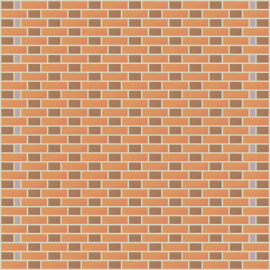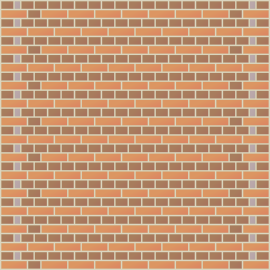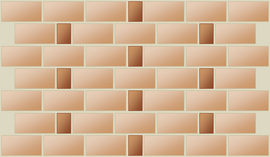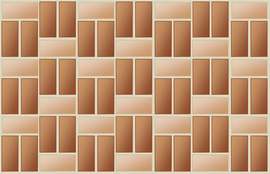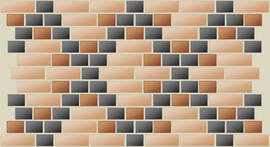Brickwork
This article needs additional citations for verification. (March 2020) |



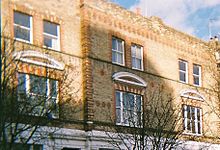
Brickwork is masonry produced by a bricklayer, using bricks and mortar. Typically, rows of bricks called courses[1][2] are laid on top of one another to build up a structure such as a brick wall.
Bricks may be differentiated from blocks by size. For example, in the UK a brick is defined as a unit having dimensions less than 337.5 mm × 225 mm × 112.5 mm (13.3 in × 8.9 in × 4.4 in) and a block is defined as a unit having one or more dimensions greater than the largest possible brick.[3]
Brick is a popular medium for constructing buildings, and examples of brickwork are found through history as far back as the Bronze Age. The fired-brick faces of the ziggurat of ancient Dur-Kurigalzu in Iraq date from around 1400 BC, and the brick buildings of ancient Mohenjo-daro in modern day Pakistan were built around 2600 BC. Much older examples of brickwork made with dried (but not fired) bricks may be found in such ancient locations as Jericho in Palestine, Çatal Höyük in Anatolia, and Mehrgarh in Pakistan. These structures have survived from the Stone Age to the modern day.


Brick dimensions are expressed in construction or technical documents in two ways as co-ordinating dimensions and working dimensions.
- Coordination dimensions are the actual physical dimensions of the brick with the mortar required on one header face, one stretcher face and one bed.
- Working dimensions is the size of a manufactured brick. It is also called the nominal size of a brick.
Brick size may be slightly different due to shrinkage or distortion due to firing, etc.
An example of a co-ordinating metric commonly used for bricks in the UK is as follows:[4][5][6]
- Bricks of dimensions 215 mm × 102.5 mm × 65 mm;
- Mortar beds (horizontal) and perpends (vertical) of a uniform 10 mm.
In this case the co-ordinating metric works because the length of a single brick (215 mm) is equal to the total of the width of a brick (102.5 mm) plus a perpend (10 mm) plus the width of a second brick (102.5 mm).
There are many other brick sizes worldwide, and many of them use this same co-ordinating principle.
Terminology
[edit]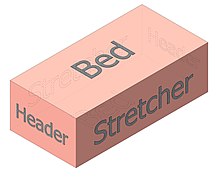
As the most common bricks are rectangular prisms, six surfaces are named as follows:
- Top and bottom surfaces are called beds
- Ends or narrow surfaces are called headers or header faces
- Sides or wider surfaces are called stretchers or stretcher faces[7]

Mortar placed between bricks is also given separate names with respect to their position. Mortar placed horizontally below or top of a brick is called a bed, and mortar placed vertically between bricks is called a perpend.





A brick made with just rectilinear dimensions is called a solid brick. Bricks might have a depression on both beds or on a single bed. The depression is called a frog, and the bricks are known as frogged bricks. Frogs can be deep or shallow but should never exceed 20% of the total volume of the brick. Cellular bricks have depressions exceeding 20% of the volume of the brick. Perforated bricks have holes through the brick from bed to bed, cutting it all the way. Most of the building standards and good construction practices recommend the volume of holes should not exceed 20% of the total volume of the brick.[7]
Parts of brickwork include bricks, beds and perpends. The bed is the mortar upon which a brick is laid.[8] A perpend is a vertical joint between any two bricks and is usually—but not always—filled with mortar.[9]
A "face brick" is a higher-quality brick, designed for use in visible external surfaces in face-work, as opposed to a "filler brick" for internal parts of the wall, or where the surface is to be covered with stucco or a similar coating, or where the filler bricks will be concealed by other bricks (in structures more than two bricks thick).
Orientation
[edit]A brick is given a classification based on how it is laid, and how the exposed face is oriented relative to the face of the finished wall.
- Stretcher or stretching brick
- A brick laid flat with its long narrow side exposed.[10]
- Header or heading brick
- A brick laid flat with its width exposed.[10]
- Soldier
- A brick laid vertically with its long narrow side exposed.[11]
- Sailor
- A brick laid vertically with the broad face of the brick exposed.[12]
- Rowlock
- A brick laid on the long narrow side with the short end of the brick exposed.[13]
- Shiner or rowlock stretcher
- A brick laid on the long narrow side with the broad face of the brick exposed.[14]
Cut
[edit]The practice of laying uncut full-sized bricks wherever possible gives brickwork its maximum possible strength. In the diagrams below, such uncut full-sized bricks are coloured as follows:
- Stretcher
- Header
Occasionally though a brick must be cut to fit a given space, or to be the right shape for fulfilling some particular purpose such as generating an offset—called a lap—at the beginning of a course.[15] In some cases these special shapes or sizes are manufactured. In the diagrams below, some of the cuts most commonly used for generating a lap are coloured as follows:
- Three-quarter bat, stretching
- A brick cut to three-quarters of its length, and laid flat with its long, narrow side exposed.
- Three-quarter bat, heading
- A brick cut to three-quarters of its length, and laid flat with its short side exposed.
- Half bat
- A brick cut in half across its length, and laid flat.
- Queen closer
- A brick cut in half down its width, and laid with its smallest face exposed and standing vertically. A queen closer is often used for the purpose of creating a lap.[16]
Less frequently used cuts are all coloured as follows:
- Quarter bat
- A brick cut to a quarter of its length.
- Three-quarter queen closer
- A queen closer cut to three-quarters of its length.
- King closer
- A brick with one corner cut away, leaving one header face at half its standard width.[17]
Bonding
[edit]A nearly universal rule in brickwork is that perpends should not be contiguous across courses.[18]
Walls, running linearly and extending upwards, can be of varying depth or thickness. Typically, the bricks are laid also running linearly and extending upwards, forming wythes or leafs. It is as important as with the perpends to bond these leaves together. Historically, the dominant method for consolidating the leaves together was to lay bricks across them, rather than running linearly.
Brickwork observing either or both of these two conventions is described as being laid in one or another bond.[19][20]
Thickness (and leaves)
[edit]A leaf is as thick as the width of one brick, but a wall is said to be one brick thick if it as wide as the length of a brick. Accordingly, a single-leaf wall is a half brick thickness; a wall with the simplest possible masonry transverse bond[definition needed] is said to be one brick thick, and so on.[21]
The thickness specified for a wall is determined by such factors as damp proofing considerations, whether or not the wall has a cavity, load-bearing requirements, expense, and the era during which the architect was or is working.[22][23] Wall thickness specification has proven considerably various, and while some non-load-bearing brick walls may be as little as half a brick thick, or even less when shiners are laid stretcher bond in partition walls, others brick walls are much thicker. The Monadnock Building in Chicago, for example, is a very tall masonry building, and has load-bearing brick walls nearly two metres thick at the base.[24] The majority of brick walls are however usually between one and three bricks thick. At these more modest wall thicknesses, distinct patterns have emerged allowing for a structurally sound layout of bricks internal to each particular specified thickness of wall.
Cavity walls and ties
[edit]The advent during the mid twentieth century of the cavity wall saw the popularisation and development of another method of strengthening brickwork—the wall tie. A cavity wall comprises two totally discrete walls, separated by an air gap, which serves both as barrier to moisture and heat.[25][26] Typically the main loads taken by the foundations are carried there by the inner leaf, and the major functions of the external leaf are to protect the whole from weather, and to provide a fitting aesthetic finish.
Despite there being no masonry connection between the leaves, their transverse rigidity still needs to be guaranteed.[27] The device used to satisfy this need is the insertion at regular intervals of wall ties into the cavity wall's mortar beds.[28][29]
Load-bearing bonds
[edit]Courses of mixed headers and stretchers
[edit]Flemish bond
[edit]
Flemish bond has one stretcher between headers, with the headers centred over the stretchers in the courses below.[30]
Where a course begins with a quoin stretcher, the course will ordinarily terminate with a quoin stretcher at the other end. The next course up will begin with a quoin header. For the course's second brick, a queen closer is laid, generating the lap of the bond. The third brick along is a stretcher, and is—on account of the lap—centred above the header below. This second course then resumes its paired run of stretcher and header, until the final pair is reached, whereupon a second and final queen closer is inserted as the penultimate brick, mirroring the arrangement at the beginning of the course, and duly closing the bond.
Some examples of Flemish bond incorporate stretchers of one colour and headers of another. This effect is commonly a product of treating the header face of the heading bricks while the bricks are being baked as part of the manufacturing process. Some of the header faces are exposed to wood smoke, generating a grey-blue colour, while other simply vitrified until they reach a deeper blue colour. Some headers have a glazed face, caused by using salt in the firing. Sometimes Staffordshire Blue bricks are used for the heading bricks.[31][32]
Brickwork that appears as Flemish bond from both the front and the rear is double Flemish bond, so called on account of the front and rear duplication of the pattern. If the wall is arranged such that the bricks at the rear do not have this pattern, then the brickwork is said to be single Flemish bond.[33]
Flemish bond brickwork with a thickness of one brick is the repeating pattern of a stretcher laid immediately to the rear of the face stretcher, and then next along the course, a header. A lap (correct overlap) is generated by a queen closer on every alternate course:
Double Flemish bond of one brick's thickness: overhead sections of alternate (odd and even) courses, and side elevation

The colour-coded plans highlight facing bricks in the east–west wall. An elevation for this east–west wall is shown to the right.
A simple way to add some width to the wall would be to add stretching bricks at the rear, making a Single Flemish bond one and a half bricks thick:
Overhead sections of alternate (odd and even) courses of single Flemish bond of one and a half bricks' thickness

The colour-coded plans highlight facing bricks in the east–west wall. An elevation for this east–west wall is shown to the right.
For a double Flemish bond of one and a half bricks' thickness, facing bricks and the bricks behind the facing bricks may be laid in groups of four bricks and a half-bat. The half-bat sits at the centre of the group and the four bricks are placed about the half-bat, in a square formation. These groups are laid next to each other for the length of a course, making brickwork one and a half bricks thick.[34][35]
To preserve the bond, it is necessary to lay a three-quarter bat instead of a header following a quoin stretcher at the corner of the wall. This fact has no bearing on the appearance of the wall; the choice of brick appears to the spectator like any ordinary header:
Overhead plans of alternate (odd and even) courses of double Flemish bond of one and a half bricks' thickness

For a more substantial wall, a header may be laid directly behind the face header, a further two headers laid at 90° behind the face stretcher, and then finally a stretcher laid to the rear of these two headers. This pattern generates brickwork a full two bricks thick:
Overhead sections of alternate (odd and even) courses of double Flemish bond of two bricks' thickness

The colour-coded plans highlight facing bricks in the east–west wall. An elevation for this east–west wall is shown to the right.
Overhead sections of alternate (odd and even) courses of double Flemish bond of two and a half bricks' thickness

The colour-coded plans highlight facing bricks in the east–west wall. An elevation for this east–west wall is shown to the right.
For a still more substantial wall, two headers may be laid directly behind the face header, a further two pairs of headers laid at 90° behind the face stretcher, and then finally a stretcher laid to the rear of these four headers. This pattern generates brickwork a full three bricks thick:
Overhead sections of alternate (odd and even) courses of double Flemish bond of three bricks' thickness

The colour-coded plans highlight facing bricks in the east–west wall. An elevation for this east–west wall is shown to the right.
Monk bond
[edit]This bond has two stretchers between every header with the headers centred over the perpend between the two stretchers in the course below in the bond's most symmetric form.[36]
The great variety of monk bond patterns allow for many possible layouts at the quoins, and many possible arrangements for generating a lap. A quoin brick may be a stretcher, a three-quarter bat, or a header. Queen closers may be used next to the quoins, but the practice is not mandatory.
Raking monk bonds
[edit]Monk bond may however take any of a number of arrangements for course staggering. The disposal of bricks in these often highly irregular raking patterns can be a challenging task for the bricklayer to correctly maintain while constructing a wall whose courses are partially obscured by scaffold, and interrupted by door or window openings, or other bond-disrupting obstacles. If the bricklayer frequently stops to check that bricks are correctly arranged, then masonry in a raking monk bond can be expensive to build.[37]
Occasionally, brickwork in such a raking monk bond may contain minor errors of header and stretcher alignment some of which may have been silently corrected by incorporating a compensating irregularity into the brickwork in a course further up the wall. In spite of these complexities and their associated costs, the bond has proven a common choice for constructing brickwork in the north of Europe.
Raking courses in monk bond may—for instance—be staggered in such a way as to generate the appearance of diagonal lines of stretchers. One method of achieving this effect relies on the use of a repeating sequence of courses with back-and-forth header staggering. In this grouping, a header appears at a given point in the group's first course. In the next course up, a header is offset one and a half stretcher lengths to the left of the header in the course below, and then in the third course, a header is offset one stretcher length to the right of the header in the middle course. This accented swing of headers, one and a half to the left, and one to the right, generates the appearance of lines of stretchers running from the upper left hand side of the wall down to the lower right. Such an example of a raking monk bond layout is shown in the New Malden Library, Kingston upon Thames, Greater London.
Elsewhere, raking courses in monk bond may be staggered in such a way as to generate a subtle appearance of indented pyramid-like diagonals. Such an arrangement appears in the picture here from the building in Solna, Sweden.
Many other particular adjustments of course alignment exist in monk bond, generating a variety of visual effects which differ in detail, but often having the effect of directing a viewing eye diagonally down the wall.[38]
Overhead plan for alternate courses of monk bond of one brick's thickness

The colour-coded plans highlight facing bricks in the east–west wall. An elevation for this east–west wall is shown to the right.
Sussex bond
[edit]This bond has three stretchers between every header, with the headers centred above the midpoint of three stretchers in the course below.[39]
The bond's horizontally extended proportion suits long stretches of masonry such as garden walls or the run of brickwork over a ribbon window; conversely, the bond is less suitable for a surface occupied by many features, such as a Georgian façade. The relatively infrequent use of headers serves to make Sussex bond one of the less expensive bonds in which to build a wall, as it allows for the bricklayer to proceed rapidly with run after run of three stretchers at a time.[40]
One stretching course per heading course
[edit]-
English bond
-
English cross bond
-
Double English cross bond
One of the two kinds of course in this family of bonds is called a stretching course, and this typically comprises nothing but stretchers at the face from quoin to quoin. The other kind of course is the heading course, and this usually consists of headers, with two queen closers—one by the quoin header at either end—to generate the bond.[41]
English bond
[edit]This bond has alternating stretching and heading courses, with the headers centred over the midpoint of the stretchers, and perpends in each alternate course aligned. Queen closers appear as the second brick, and the penultimate brick in heading courses.[42][43] A muted colour scheme for occasional headers is sometimes used in English bond to lend a subtle texture to the brickwork. Examples of such schemes include blue-grey headers among otherwise red bricks—seen in the south of England—and light brown headers in a dark brown wall, more often found in parts of the north of England.[44]
Overhead plan for alternate courses of English bond of one brick's thickness

The colour-coded plans highlight facing bricks in the east–west wall. An elevation for this east–west wall is shown to the right.
Overhead plan for alternate courses of English bond of one and a half bricks' thickness

The colour-coded plans highlight facing bricks in the east–west wall. An elevation for this east–west wall is shown to the right.
Overhead plan for alternate courses of English bond of two bricks' thickness

The colour-coded plans highlight facing bricks in the east–west wall. An elevation for this east–west wall is shown to the right.
English cross bond
[edit]
This bond also has alternating stretching and heading courses. However, whilst the heading courses are identical with those found in the standard English bond, the stretching courses alternate between a course composed entirely of stretchers, and a course composed of stretchers half off-set relative to the stretchers two courses above or below, by reason of a header placed just before the quoins at either end.[45][46] The bond is widely found in Northern France, Belgium and the Netherlands.[47]
Large areas of English cross bond can appear to have a twill like characteristic, an effect caused by the unbroken series of perpends moving diagonally down the bond.
Dutch bond
[edit]This bond is exactly like English cross bond except in the generating of the lap at the quoins. In Dutch bond, all quoins are three-quarter bats—placed in alternately stretching and heading orientation with successive courses—and no use whatever is made of queen closers.[48] To the Dutch this is simply a variant of what they call a cross bond.[49]
Two or more stretching course per heading course
[edit]-
A raking English garden wall bond
-
Scottish bond
-
American bond
English garden wall bond
[edit]This bond has three courses of stretchers between every course of headers.[50]
For the standard English garden wall bond, headers are used as quoins for the middle stretching course in order to generate the lap, with queen closers as the penultimate brick at either end of the heading courses. A more complex set of quoins and queen closers is necessary to achieve the lap for a raking English garden wall bond.
The heading course in English garden wall bond sometimes features bricks of a different colour to its surrounding stretchers. In English chalk districts, flint is substituted for the stretchers, and the headers constitute a lacing course.[44]
Scottish bond
[edit]This bond has five courses of stretchers between every course of headers.
The lap is generated by the use of headers as quoins for the even-numbered stretching courses, counting up from the previous heading course, with queen closers as the penultimate brick at either end of the heading courses.
American, or common bond
[edit]

This bond may have between three and nine courses of stretchers between each course of headers. Six is the most common number of courses of stretchers.
Headers are used as quoins for the even-numbered stretching courses, counting up from the previous heading course, in order to achieve the necessary off-set in a standard American bond, with queen closers as the penultimate brick at either end of the heading courses.
The brick Clarke-Palmore House in Henrico County, Virginia, has a lower level built in 1819 described as being American bond of three to five stretching courses between each heading course, and an upper level built in 1855 with American bond of six to seven stretching courses between each heading course.[51]
Only stretching or heading courses
[edit]-
Header bond
-
Stretcher bond
-
A raking stretcher bond
Header bond
[edit]All bricks in this bond are headers, but for the lap-generating quoin three-quarter bat which offsets each successive courses by half a header.
Header bond is often used on curving walls with a small radius of curvature. In Lewes, Sussex, England UK many small buildings are constructed in this bond, using blue coloured bricks and vitrified surfaces.[52][53]
Stretcher, or running bond
[edit]All bricks in this bond are stretchers, with the bricks in each successive course staggered by half a stretcher. Headers are used as quoins on alternating stretching courses in order to achieve the necessary off-set.
It is the simplest repeating pattern, and will create a wall one header thick.
Raking stretcher bond
[edit]Also consists entirely of courses of stretchers, but with the bricks in each successive course staggered in some pattern other than that of standard stretcher bond.[54]
One or more stretching courses per alternating course
[edit]Flemish stretcher bond
[edit]-
Flemish stretcher bond
Flemish stretcher bond separates courses of alternately laid stretchers and headers, with a number of courses of stretchers alone. Brickwork in this bond may have between one and four courses of stretchers to one course after the Flemish manner.[36][55] The courses of stretchers are often but not always staggered in a raking pattern.
Courses of mixed rowlocks and shiners
[edit]Rat-trap bond
[edit]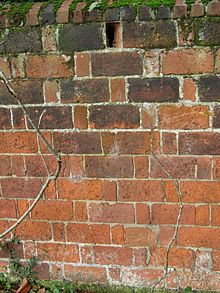
Rat-trap bond (also Chinese bond) substantially observes the same pattern as Flemish bond, but consists of rowlocks and shiners instead of headers and stretchers. This gives a wall with an internal cavity bridged by the rowlocks, hence the reference to rat-traps.[56]
One shiner course per heading course
[edit]Dearne's bond
[edit]Dearne's bond substantially observes the same pattern as English bond, but uses shiners in place of stretchers.[57]
Non-load-bearing bonds
[edit]
Courses of mixed shiners and sailors
[edit]Single basket weave bond
[edit]
A row of single basket weave bond comprises pairs of sailors laid side-by-side, capped with a shiner, alternating with pairs of sailors laid side-by-side sat atop a shiner. Subsequent rows are identical and aligned with those above.[58]
Double basket weave bond
[edit]A row of double basket weave bond comprises pairs of shiners laid atop one another, alternating with pairs of sailors laid side by side. The following row is off-set so the pair of shiners sits below the pair of sailors in the row above. This results in bricks arranged in pairs in a square grid so that the join between each pair is perpendicular to the join of the four pairs around it.[54]
Herringbone bond
[edit]The herringbone pattern (opus spicatum) made by placing soldiers next to stretchers or vice versa (i.e. headers perpendicular) making 'L' shapes, nesting each L in the same order of laying. Thin bricks are more common. The pattern is usually rotated by 45° to create a completely vertical (plumb) succession of 'V' shapes. It follows either the left or right brick forms the tip of the v in any wall. Herringbone is sometimes used as infill in timber-framed buildings.[54]
Brickwork built around square fractional-sized bricks
[edit]Pinwheel bond
[edit]Pinwheel bond is made of four bricks surrounding a square half-brick, repeated in a square grid.[54]
Della Robbia bond
[edit]A pattern made of four bricks surrounding a square brick, one-quarter the size of a half-brick. It is designed to resemble woven cloth.[54] Another, similar pattern is called the interlacing bond.[59]
Diapering
[edit]
Brickwork formed into a diamond pattern is called diapering.
Flemish diagonal bond
[edit]Flemish diagonal bond comprises a complex pattern of stretcher courses alternating with courses of one or two stretchers between headers, at various offsets, such that over ten courses, a diamond-shaped pattern appears.
Damp-proof courses
[edit]Moisture may ascend into a building from the foundation of a wall or gain ingress into a building from a wet patch of ground, where it meets a solid wall. The manifest result of this process is called damp. One of many methods of resisting such ingresses of water is to construct the wall with several low courses of dense engineering bricks such as Staffordshire blue bricks. This method of damp proofing appears as a distinctive navy blue band running around the circumference of a building. It is only partially effective, as in spite of the lower courses of brick being more moisture resistant the mortar bedding and perpends joining the bricks remain permeable.[60]
See also
[edit]- Brick Expressionism – Architectural style
- Ceramic building material – Archaeological term for baked clay building material
- Construction – Process of building or assembling a building or infrastructure
- Glossary of British bricklaying – List of bricklaying terms and their meanings
- Masonry – Building of structures from individual units of stone, bricks, or blocks
- Tuckpointing – Method of pointing brickwork
References
[edit]- ^ Joseph Moxon. Mechanick Exercises: Or, The Doctrine of Handy-Works. Applied to the Arts of Smithing, Joinery, Carpentry, Turning, Bricklaying. Printed for Daniel Midwinter and Thomas Leigh. 1703. London. Page 129. "Three or four or five courses of Bricks to be laid."
- ^ Nicholson. "By a Course, in walling, is meant the bricks contained between two planes parallel to the horizon, and terminated by the faces of the wall. The thickness is that of one brick with mortar. The mass formed by bricks laid in concentric order, for arches or vaults, is also denominated a Course."
- ^ Fleming, Eric (2006). Construction Technology. UK: Blackwell Publishing Ltd. p. 2. ISBN 1-4051-0210-1.
- ^ Brunskill, p. 39. "British Standard 3921 of 1969, gave dimensions of 215 mm by 102.5 mm by 65 mm [...]."
- ^ British Standards Institution. Specification for Masonry Units. Part 1: Clay Masonry Units. BSI, London, 2003, BS EN 771.
- ^ The Compressive Strength of Modern Earth Masonry, Andrew Heath, Mike Lawrence, Peter Walker and Clyde Fourie. BRE Centre for Innovative Construction Materials, University of Bath and Natural Building Technologies (NBT). Proceedings of the 11th International Conference on Non-conventional Materials and Technologies (NOCMAT 2009). 6–9 September 2009, Bath, UK. "All earth masonry units were intended to be 'standard' brick size (215x102.5x65mm) if they were fired, but because they did not have additional shrinkage from firing, the average size was 223x106x67mm."
- ^ a b Fleming, Eric (2006). Construction Technology. UK: Blackwell Publishing Ltd. ISBN 1-4051-0210-1.
- ^ Nicholson, p. 166. "BED.—The under-surface of bricks when laid in any kind of work."
- ^ Reports of artisans selected by a committee appointed by the council of the Society of Arts to visit the Paris Universal exhibition, 1867. Published for the Society for the Encouragement of Arts, Manufactures and Commerce. Published by Bell and Daldy, York Street, Covent Garden, London. Printed by W. Trounce, Cursitor Street, Chancery Lane, London. 1867. Part 1. Bricklaying by George Howell. Page 194. "The beauty of brickwork will very much depend upon the 'perpends' being perfectly kept, that is, the perfect regularity of the perpendicular joints right up the building."
- ^ a b John Houghton. A Collection for Improvement of Husbandry and Trade. 1693. Issue 74. Published by Randal Taylor near Stationers-Hall. London. "A Brick-wall of a Foot and half thick is commonly made by Stretchers and Headers, that is, by laying on the out-side one Brick, so as to have the narrowest side of it to be seen longways, and the next to have only the end seen, and the Brick lying on the broad side, and so on, a Stretcher and a Header."
- ^ Whitney Clark Huntington. Building Construction. Types of Construction, Materials, and Cost Estimating. New York: Wiley. London: Chapman & Hall. 1929. Page 130. "Belt courses and flat arches may be formed of brick[s] set on end with the narrow side exposed. Such bricks are called soldiers."
- ^ Sovinski, p. 43. "Those brick positions oriented in a horizontal alignment are called stretcher, header, rowlock stretcher, and rowlock. A rowlock stretcher is sometimes called a shiner. The two corresponding vertical orientations are the soldier and sailor positions."
- ^ Samuel Y. Harris. Building Pathology. Wiley. New York. 2001. Page 212. "The short face, or the end laid horizontally, is a header; laid vertically, a rowlock."
- ^ Sovinski, p. 43. "Those brick positions oriented in a horizontal alignment are called stretcher, header, rowlock stretcher, and rowlock. A rowlock stretcher is sometimes called a shiner."
- ^ Charles F.Mitchell. Building Construction. Part 1. First Stage or Elementary Course. Second Edition—Revised. Published by B.T. Batsford, 52 High Holborn. 1889. Page 22.
- ^ Encyclopædia Britannica. 1911. BRICKWORK. "[...] portions of a brick [...] a half header in width, [...] are called queen closers[.]"
- ^ Charles F.Mitchell. Building Construction. Part 1. First Stage or Elementary Course. Second Edition—Revised. Published by B.T. Batsford, 52 High Holborn. 1889. Page 18. "King Closers are bricks cut so that one end is half the width of a brick, and [are] used in positions where the greater width at back would add strength to the bond[...]."
- ^ Nicholson, p. 167. "[...] an arrangement, or combination of bricks when laid upon each other, [such] that the perpendicular joint formed by any two adjacent bricks may, at all times, be covered by the centre (or nearly so) of one laid immediately over the joint, by which means the nearest approximation to solidity will be attained that such materials are capable of producing."
- ^ Nicholson, p. 347. "BRICKS ARE LAID in a varied, but regular, form of connection, or Bond, as exhibited in Plate LXXXV."
- ^ Nicholson, p. 329. "BOND.—That regular connection, in lapping the stones upon one another, when carrying up the work, which forms an inseparable mass of building."
- ^ CITB
CONSTRUCTION INDUSTRY TRAINING BOARD
Training Workbook
Setting Out Brickwork
Positioning Ranging Lines, Gauge, Dry Bonding, Broken Bonding
WB 272
Construction Industry Training Board, Bircham Newton, Kings Lynn, Norfolk PE31 6RH. 1994. ISBN 185751095X. Page 35–37. "Wall thickness terms relate to a stretcher dimension of a brick. Wall (A) [pictured] is termed a half brick wall. Wall (B) [pictured] is termed a one brick wall [...]. This wall is a half brick thick wall [...]. This wall is a one brick thick wall [...]." - ^ Bricks and Brickwork. Cecil C. Handisyde and Barry A. Haseltine. The Brick Development Association. 19 Grafton Street, London, W1X 3LE. 1974. Page 68. "Old buildings of solid wall construction were accepted as 'waterproof', often when brickwork was only 9 inches [23 cm] thick. Now it is generally agreed that solid walls of less than [one and a half] brick thickness are inadequate. Code of Practice 121 still includes unrendered one brick thick walls as acceptable for sheltered positions but this seems a questionable recommendation. Walling of [one and a half] brick thickness should be satisfactory for sheltered positions and may be adequate for moderate exposure."
- ^ Emmitt, p. 206. "In exposed positions such as high ground and near the coast, a wall 2B thick may be needed to resist penetration to inside faces [...]. In positions of very severe exposure to wind-driven rain, as on high open ground facing the prevailing wind and on the coast facing open sea, it is necessary to protect both solid and cavity walls with an external cladding."
- ^ Fuller, Chicago Tribune, December 7, 1958.
- ^ Denzil Nield. Walls & Wall Facings. Spon, London. 1949. Page 145. "Cavity walls... are being increasingly built with hollow blocks or other material in place of bricks for the internal leaf."
- ^ New Civil Engineer. Oct 3rd, 1991. Thomas Telford Ltd. London. Advertisement. "Single leaf wall with vertical and lateral load."
- ^ Emmitt, p. 7
- ^ Emmitt, pp. 232, 233. "Early cavity walls were constructed with bonding bricks laid across the cavity at internals to tie the two leaves together. [...] Later, iron ties were used to tie the two leaves together."
- ^ David Yeomans. Construction Since 1900: Materials. BT Batsford Ltd, 583 Fulham Road, London, SW6 5BY. 1997. ISBN 0713466847. Page 60. "In 1974, a large section of the outer leaf of a wall of a comprehensive school at Newnham collapsed revealing a complete absence of ties over a considerable area [and] in 1983, a much larger section of a wall at Plymouth Polytechnic collapsed due to corrosion of the cavity ties."
- ^ Smeaton, pp. 29–30. "The two principal methods of bricklaying are severally called English and Flemish bond. [...] Flemish bond consists in placing a header and a stretcher alternately throughout every course."
- ^ Brunskill, pp. 57–58.
- ^ Arch. Review, p. 233.
- ^ Brunskill, p. 91. "SINGLE FLEMISH BOND: gives the appearance of Flemish Bond on the outside face only of a wall more than 9 inches [23 cm] thick. The same appearance on both inner and outer faces is given by DOUBLE FLEMISH BOND."
- ^ Nicholson, p. 102. "[...] the bricks are disposed alike on both sides of the wall, the tail of the headers being placed contiguous to each other, so as to form square spaces in the core of the wall for half-bricks."
- ^ Charles F.Mitchell. Building Construction. Part 1. First Stage or Elementary Course. Second Edition—Revised. Published by B.T. Batsford, 52 High Holborn. 1889. Page 25, figures 37 & 38.
- ^ a b The Dictionary of Art. Grove. Volume Four, Biardeau TO Brüggemann. Edited by Jane Turner. Macmillan Publishers Limited. 1996. ISBN 1884446000. Page 769.
- ^ Arch. Review, p. 242. THE BONDING OF BRICKWORK. P.M. Stratton. "An extra cost over Flemish has to be met for labour on Monk bond and its derivatives, because the process is not so straightforward as Flemish, and the bricklayers have to stop and think more frequently."
- ^ Arch. Review, p. 241. THE BONDING OF BRICKWORK. P.M. Stratton. "Monk bond [...] is popular in the North of Europe. Two stretchers are followed by one header in every course, the headers being so disposed that verticality of their axial lines is little apparent, and a striking result is obtained of diagonal lines of stretchers, which look like a series of corbels or cantilevers embedded in the wall."
- ^ Lloyd, p. 440. "FLEMISH GARDEN WALL or SUSSEX BOND. Three stretchers, then one header in every course."
- ^ Arch. Review, p. 241. THE BONDING OF BRICKWORK. P.M. Stratton.
- ^ Charles F.Mitchell. Building Construction. Part 1. First Stage or Elementary Course. Second Edition—Revised. Published by B.T. Batsford, 52 High Holborn. 1889. Page 23.
- ^ Smeaton, pp. 29–30. "The two principal methods of bricklaying are severally called English and Flemish bond .... English bond consists of alternating courses of headers and stretchers; thus, one course is formed with headers, that is, with bricks crossing the wall; the next with stretchers, that is, with bricks having their length in the same direction as that of the wall[.]"
- ^ Charles F.Mitchell. Building Construction. Part 1. First Stage or Elementary Course. Second Edition—Revised. Published by B.T. Batsford, 52 High Holborn. 1889. Page 21, figures 28 & 29.
- ^ a b Arch. Review, p. 242. THE BONDING OF BRICKWORK. P.M. Stratton.
- ^ Ching, Francis (1995). A Visual Dictionary of Architecture. Wiley. ISBN 0-471-28451-3.
- ^ Lloyd, p. 440. "ENGLISH CROSS BOND. Stretchers breaking joint. The second brick of alternate stretching courses is a header."
- ^ Brunskill, p. 50.
- ^ Charles F.Mitchell. Building Construction. Part 1. First Stage or Elementary Course. Second Edition—Revised. Published by B.T. Batsford, 52 High Holborn. 1889. Page 37.
- ^ Mulder, Koen (2016). Het Zinderend Oppervlak [The Thrilling Surface] (in Dutch) (2nd ed.). Steenwijk (published January 2016). p. 10. ISBN 978-90-824668-0-5.
{{cite book}}: CS1 maint: location missing publisher (link) - ^ Lloyd, p. 440. "ENGLISH GARDEN WALL BOND. Three stretching courses to each heading course."
- ^ Susan Reed Smither (January 29, 2004). "National Register of Historic Places Registration: Clarke-Palmore House / Clarke Home" (PDF). Virginia Historic Landmarks Commission. Archived from the original (PDF) on June 7, 2010. Retrieved 2010-05-08. and Accompanying four photos at Virginia Historic Landmarks Commission, undated Archived 2010-05-28 at the Wayback Machine
- ^ Lloyd, p. 440. "HEADING BOND. All headers except a three-quarters brick at quoin in alternate courses."
- ^ Arch. Review, pp. 242, 245. THE BONDING OF BRICKWORK. P.M. Stratton.
- ^ a b c d e "Brick Patterns". Peter Stewart. Archived from the original on 2016-04-14.
- ^ Brunskill, p. 52.
- ^ Brunskill, p. 54.
- ^ Brunskill, p. 87.
- ^ "Boral Best Block". Archived from the original on 2012-05-31.
- ^ "Get It Right" (PDF). Ibstock Brick. Archived from the original (PDF) on 21 September 2013. Retrieved 26 May 2015.
- ^ Emmitt, p. 154.
Bibliography
[edit]- Brunskill, R.W. (1997). Brick Building in Britain. London: Victor Gollancz in association with Peter Crawley. An imprint of the Cassell Group. ISBN 0575065354.
- Emmitt, Stephen & Gorse, Christopher A. (2010). Barry's Introduction to Construction of Buildings. Wiley-Blackwell. ISBN 9781405188548.
- Lloyd, Nathaniel (1925). A History of English Brickwork. The Antique Collectors' Club Ltd. ISBN 0907462367.
- Nicholson, Peter (1823). The New Practical Builder, and Workman's Companion. Thomas Kelly, 17 Paternoster Row, London.
- The Architectural Review. 9 Queen Anne's Gate, Westminster, S.W.1. London: The Architectural Press. May 1936.
{{cite book}}: CS1 maint: location (link) - Plumridge, Andrew and Meulenkamp, Wim. (1993). Brickwork: Architecture and Design. New York: Harry N Abrams.
{{cite book}}: CS1 maint: multiple names: authors list (link) - Smeaton, A. C. (1837). The Builder's Pocket Manual; Containing the Elements of Building, Surveying and Architecture; with Practical Rules and Instructions in Carpentry, Bricklaying, Masonry &c. Barnard's Inn, Holborn: M. Taylor.
- Sovinski, Rob W. (1999). Brick in the Landscape. A Practical Guide to Specification and Design. New York: John Wiley & Sons.

